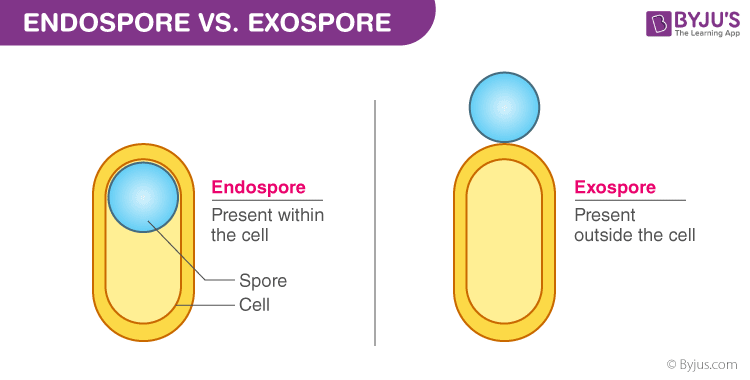Table of Contents
What are spores?
Spores are the unicellular and reproductive structures, which are greatly resistant to extreme environmental conditions, like high temperature, pH, salt concentration, etc. Such reproductive structures exist in variable, sizes, shapes and numbers. The phenomena of the formation of spores by the vegetative cells are termed Sporulation or Sporogenesis.
Explore more: Sporulation
Based on the positions, these spores are broadly classified into two types:
- Endospore
- Exospore
Endospore and Exospore
Endospores and exospores are two varieties of spores or the reproductive structures generated as resting systems.
Endospore is the common type of spores produced mainly by bacteria.
Exospores are produced in the eukaryotic cells of fungi, algae and cyanobacteria. Endospores are formed inside the mother cell, whereas, exospores are formed towards the end of the mother cell and released as bud.
Explore more: Endospores
Here, in this article let us explore more in detail the differences between Endospore and Exospore.
Endospore and Exospore – Differences

| Endospore | Exospore |
| Endospores are generated by the Clostridium Bacillus and Sporosarcina bacteria. | Exospores are produced by the members of the phylum Actinobacteria. |
| Formed within or inside the vegetative cell. | Formation outside the vegetative cell. |
| It is a structure formed by bacteria. | It is an asexual spore that is separated from the mother cell. |
| Cell division is not involved in the formation of endospores. | Exospores are produced by cell division. |
| Endospores are released by rupturing the mother cell. | Exospores are released by budding. |
| Only one endospore is produced by a single organism | Several exospores are produced by a single organism |
| Examples of endospores producing organisms are Bacillus anthracis, Bacillus cereus, Bacillus thuringiensis, Clostridium botulinum, and Clostridium tetani. | Examples of exospores producing organisms are Actinomycetes, algae and fungi. |
This concludes the major difference between the endospores and exospores. For more information on spores, sporulation, their types and functions, keep visiting our website at BYJU’S Biology.
Frequently Asked Questions on Difference Between Endospore and Exospore
What is the function of an Exospore?
Exospores are reproductive cells released from the parent organisms. They develop into a new organism.
Can bacteria produce Exospore?
Some bacteria like Actinomycetes produce exospore.
What is the difference between Akinetes and endospores?
Akinetes are dormant cells formed from bacterial cells. They are non-motile and are not resistant to heat. Whereas, the endospores are highly resistant to heat.
What is Endospore staining in microbiology?
Schaeffer-Fulton’s method is used to differentially stain the endospores and vegetative cells. The endospores appear green by retaining the Malachite green stain while the vegetative cells appear pink due to the uptake of Safranin.
Does E. Coli form endospores?
E. Coli is a gram-negative bacteria present in the intestines. It does not form endospores.

Comments